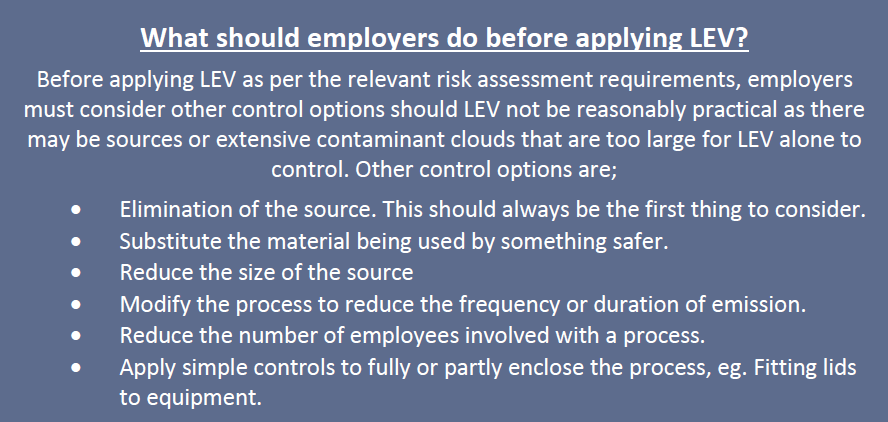 LEV (Local Exhaust Extraction) is an engineering control system to reduce exposures to airborne contaminants such as dust, mist, fumes, vapour or gas in a workplace by capturing the emission at source and transporting it to a safe emission point or to a filter/scrubber. Common components of an LEV system are as follows;
LEV (Local Exhaust Extraction) is an engineering control system to reduce exposures to airborne contaminants such as dust, mist, fumes, vapour or gas in a workplace by capturing the emission at source and transporting it to a safe emission point or to a filter/scrubber. Common components of an LEV system are as follows;
Hood: This is where the contaminant cloud enters the LEV.
Ductings: This conducts air and the contaminant from the hood to the discharge point.
Air cleaner or arrestor: This filters or cleans the extracted air. Not all systems need air cleaning.
Air mover: The ‘engine’ that powers the extraction system, usually a fan.
Discharge: This releases the extracted air to a safe place.
Understanding how LEV work
LEV Hoods
 The Hood is an integral part of ensuring correct LEV function. The type of hood is influenced by the work being done. The 3 main types are;
The Hood is an integral part of ensuring correct LEV function. The type of hood is influenced by the work being done. The 3 main types are;
- Enclosing – Encloses the works to provide the fullest extraction coverage possible. An example of enclosing LEV would be a Spray Room.
- Receiving – Provides a canopy above/adjacent to the works, semi enclosing them and receiving the harmful by-product rather than enclosing.
- Capturing – There are 3 different types of capture hood; Fixed, Moveable and LVHV (Low Volume High Velocity). LVHV often have small capturing hoods built-in.
Air Mover
The fan is the most commonly used air mover that powers the extraction system. They can be a number of types;
- Centrifugal – Most commonly used for LEV system. Generates a large pressure difference and produces a strong airt flow.
- Propeller – More often used for general ventilation and usually not suitable where there is pressure.

Classes of LEV
It pays to choose the correct class of LEV. There are 3 classes, L class, M class and H class. The L, M and H stand for low, medium and high respectively. Each protects against different types of contaminant.
- L class (eg. House dust, soil) – ≤ 1.0% Dusts with maximum allowable concentrations (MAC) > 1 mg/m³
- M class (eg. Wood dust, cement dust) – < 0.1% Dusts with maximum allowable concentrations (MAC) ≥ 0.1 mg/m³
- H class (eg. Asbestos, Bitumen, Spores) – < 0.005% Dusts with maximum allowable concentrations (MAC) < 0.1 mg/m³
If LEV is appropriate, what should you be aware of?
If LEV is deemed necessary via the relevant risk assessment, there are numerous things you, as an employer, should question and be aware of;
- The key properties of potential airborne contaminants – is LEV a suitably protective against these contaminants?
- The processes in the workplace that may be causing contaminants – can they be prevented from arising?
- The contaminant clouds moving with the surrounding air – Are drafts affecting the flow of the contaminants?
- The needs of operators working near the sources of contaminants
- How to prepare a specification for the LEV designer & what to tell them
Further care should be taken to ensure awareness of the capture zones, working zones and breathing zones, the general principles of ductwork, air movers and air cleaners and how they interact.
What is required to conduct a LEV inspection?
If you are an employee or supervisor, you are required to carry out routine LEV inspections. These checks require understanding;
- The parts of an LEV system and their function
- How LEV should be used
- How to recognise a damaged part
- The simple checks that can confirm the LEV system is delivering its design performance and continuing to provide control as required and identified in the risk assessment and control strategy.
Should LEV be tested?
The HSE states that;
- LEV extraction needs a statutory test at least once every 14 months to make sure it works as it should. Exceptions to this are provided in Schedule 4 of the COSHH regulations (2002).
- The test must be done by a competent person, testing against P601 – Thorough examination & testing of Local Exhaust Ventilation Systems.
- A record of testing must be kept for at least 5 years.

Why does LEV have to be tested?
- To ensure that your LEV is working as originally intended and is helping to protect the health of your employees.
- To ensure the test can be conducted as intended, the examiner should be provided with information about the intended/designed performance of the system, eg. Hood type and position relative to the process, airflow and other measurements. This information can be supplied by the manufacturer or in the form of an initial appraisal or commissioning report.
What does the examiner need?
Ideally, the examiner needs to know;
- What the LEV was originally intended to do
- Proof of test upon installation is available
